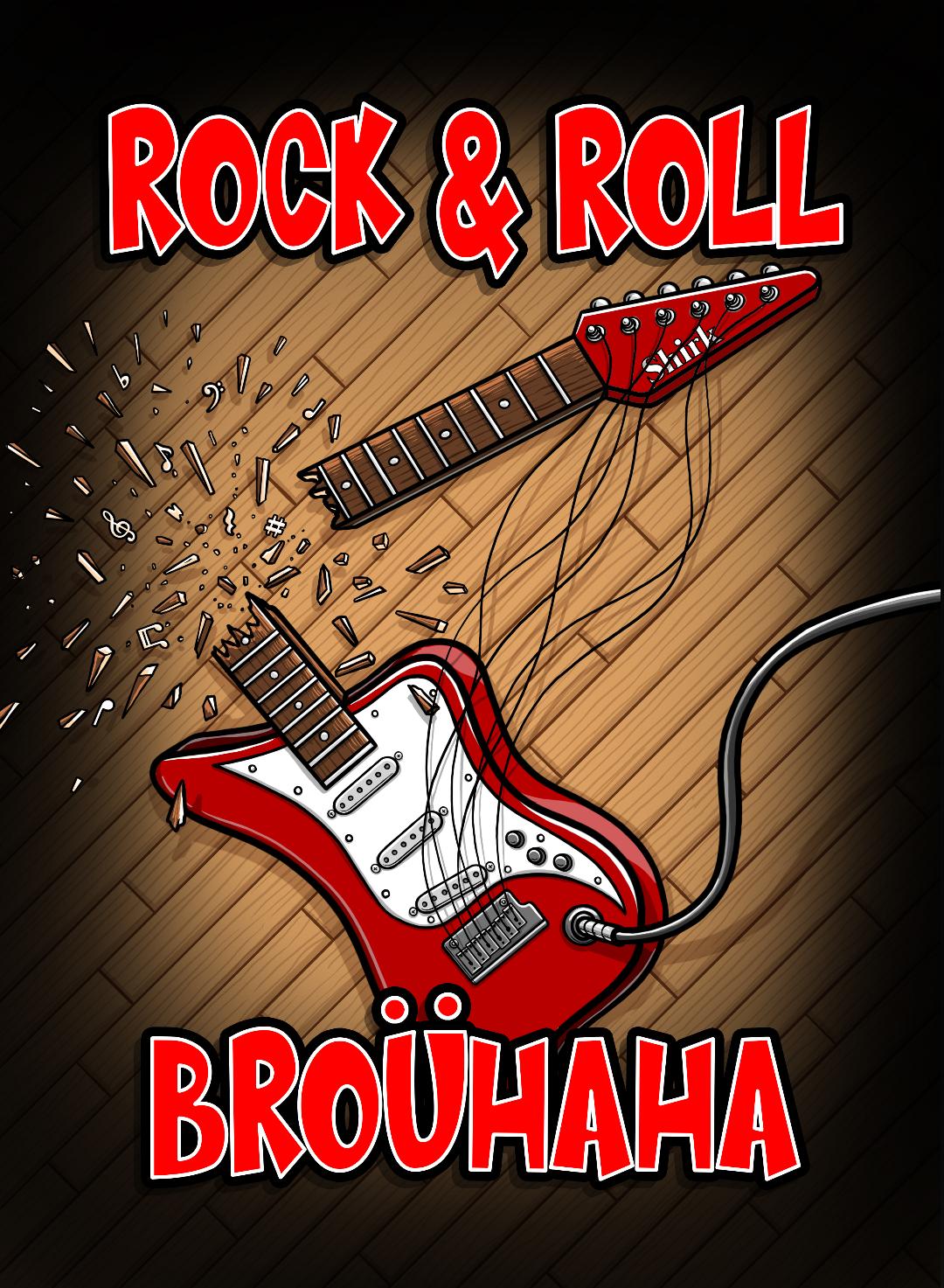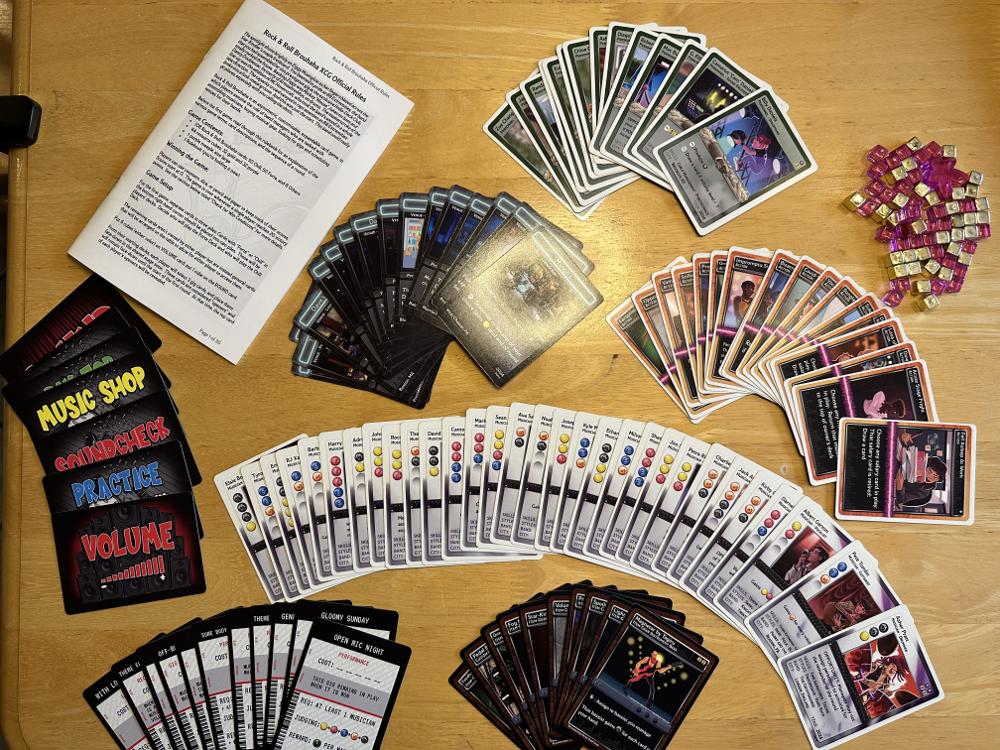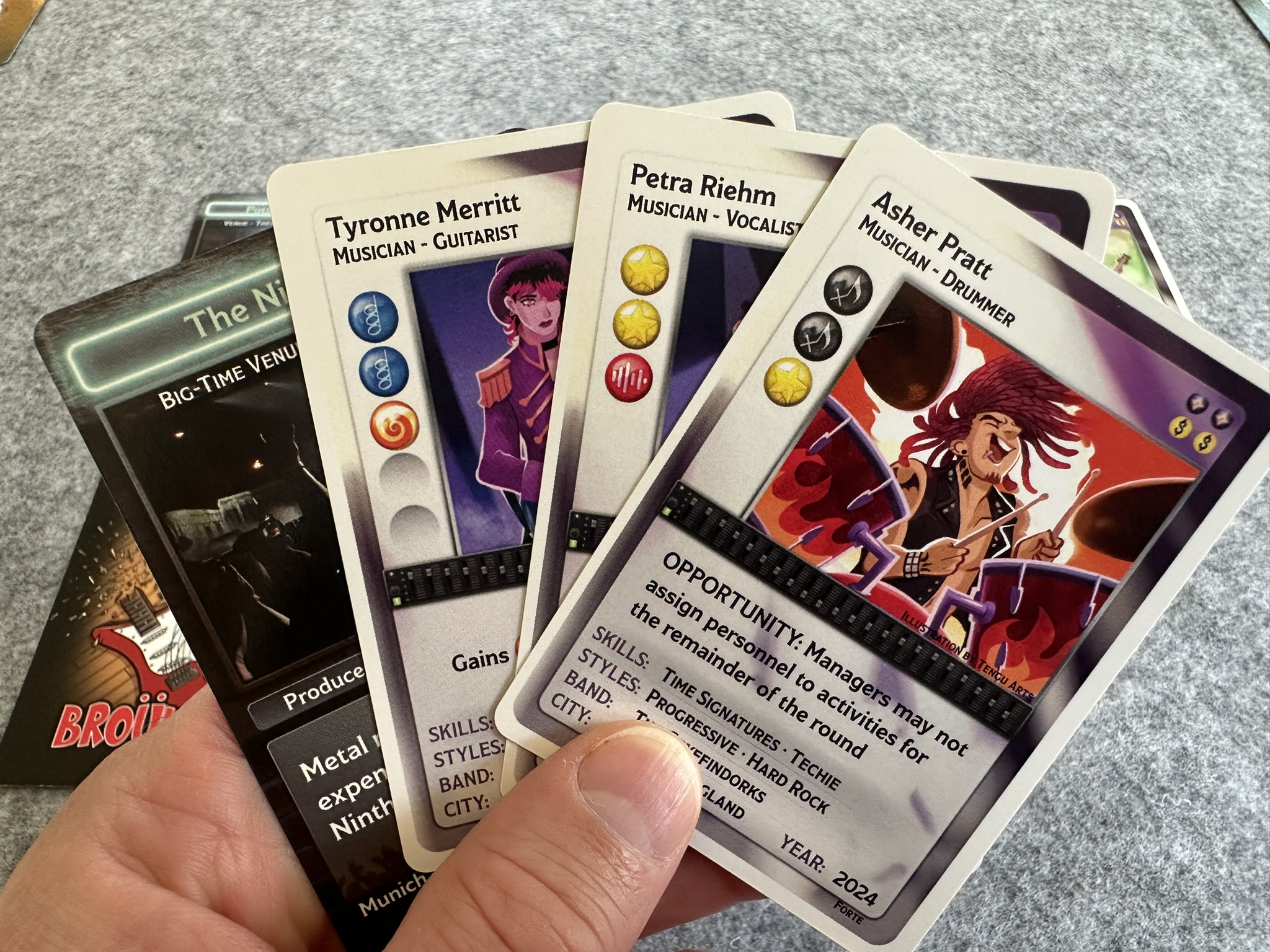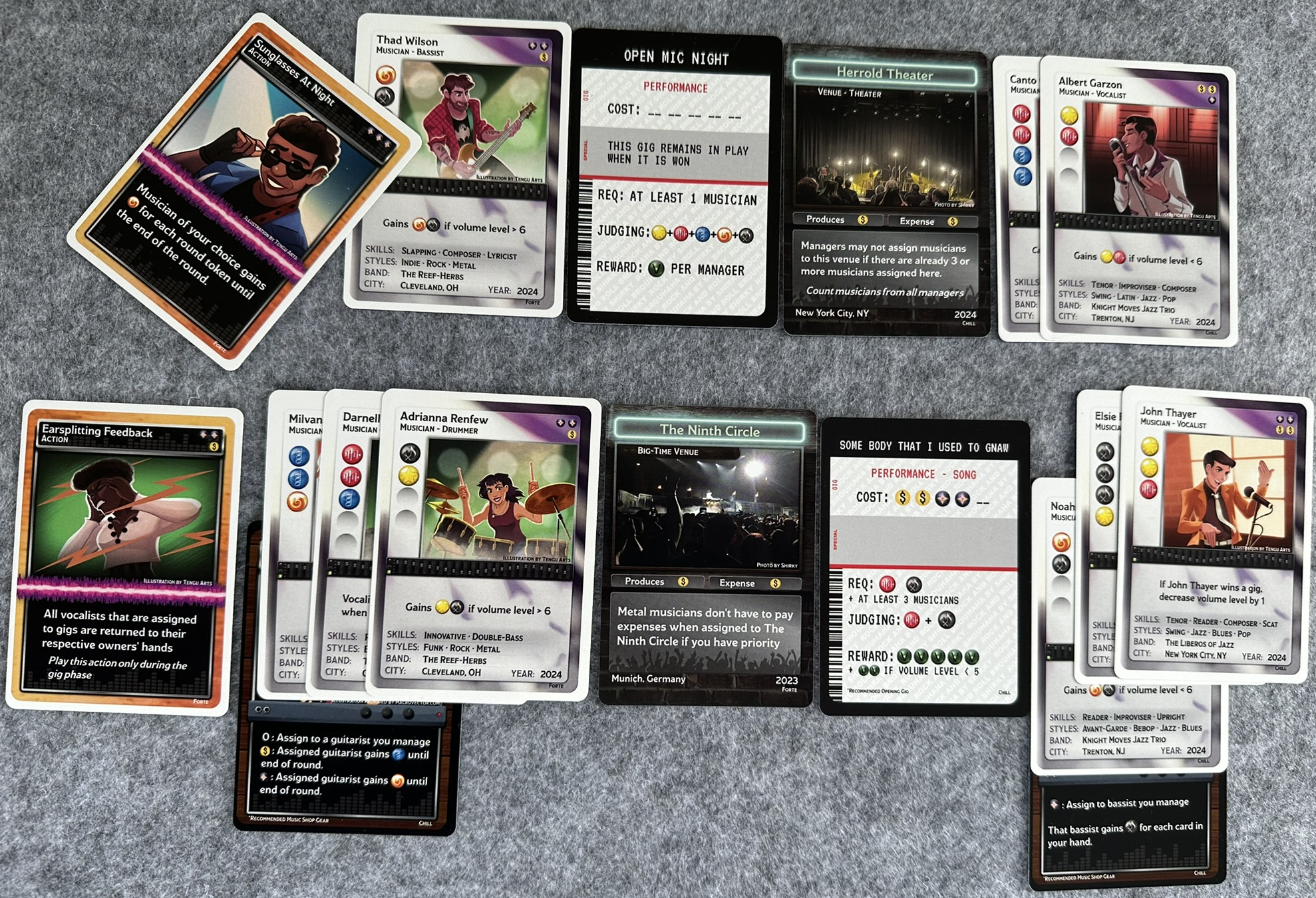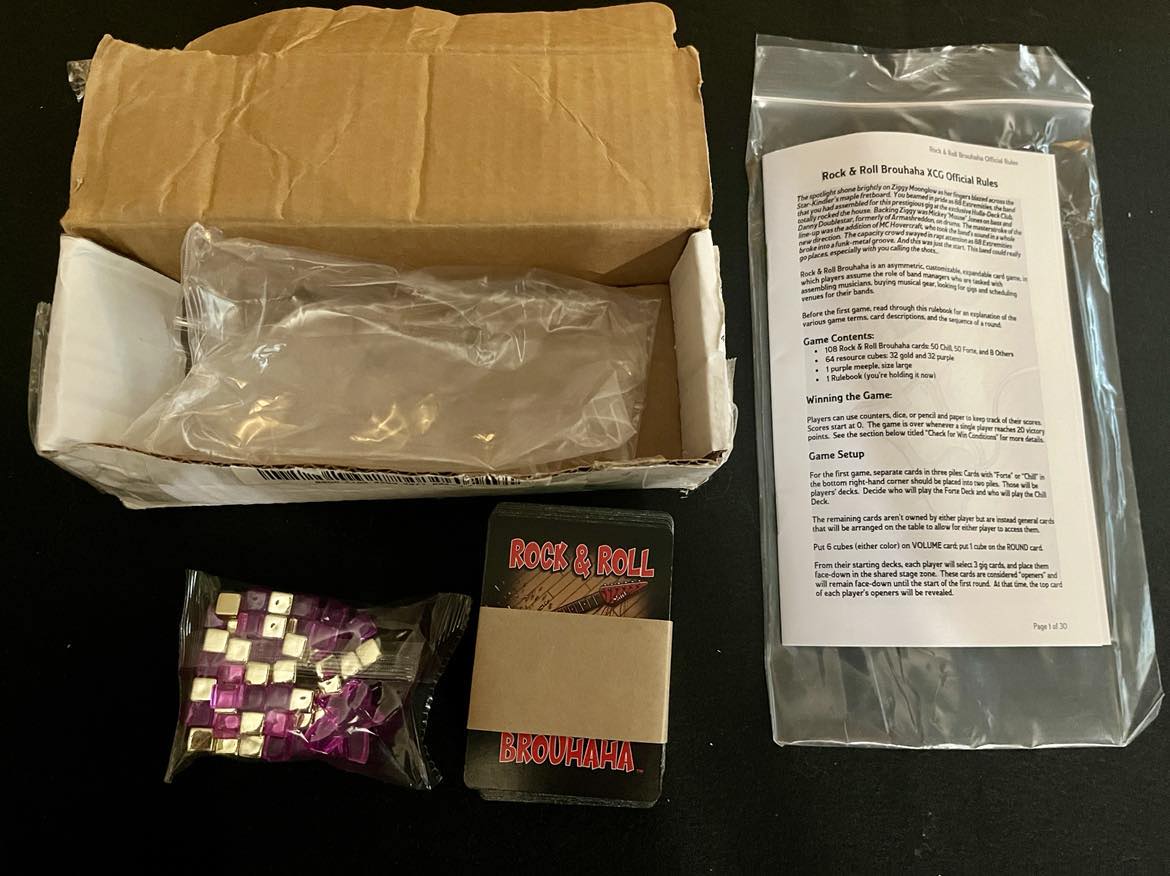While I’ve played my fair share of “Rock Band” and “Guitar Hero” in my day, I don’t think I’ve ever played a tabletop game devoted to the management of bands. In “Rock & Roll Brouhaha” (available via The Game Crafter), players will become band managers and manage musicians, buy gear, look for gigs, and schedule venues. It’s expandable to boot; I’m told that an expansion is already in the works. Before we get started, I’m required by FTC regulations to disclose that I was paid to cover this game, however any and all opinions remain my own. The only thing paid for here was my time and expertise.
2 Players, Ages 12+, Average Play Time = 60-90 Minutes
—
Components
The game consists of 108 Rock & Roll Brouhaha Cards, 64 Resource Cubes (32 Gold “$” / 32 Purple “Cred”), 1 Purple Meeple, and a Rulebook.
The cards come in different forms:
50 Chill Cards: One player will receive this deck.
50 Forte Cards: The other player will receive this deck.
The other cards are placed off to the side and arranged so that both players can access them. The Volume Card, for example, starts at “6” while the Round Card starts at “1”. Players use cubes of either color to track these. The Open Mic Night card represents a gig always available to the players. The 5 Activity cards represent alternate spaces that a musician or personnel card may be assigned to for various effects, though these effects are optional.
Setup Overview
From their starting decks, each player chooses 3 gigs and plays them face-down in the shared stage zone. They act as openers and remain that way until the start of the first round. When that happens, the top card of each player’s openers are revealed. Some gigs will have “Recommended Opening Gig” written on the bottom left to help first-time players.
Similar to the above, each player selects 3 gear cards to play into their shared Music Shop area, available to be purchased during the game. Some of these gear cards have “Recommended Music Shop Gear” written on the bottom left to help first-time players.
After this, players separately shuffle their decks and start with 1 purple cube (cred) and 1 gold cube ($1). They each draw 10 cards, choose 7 to keep, and place the remaining 3 on the bottom of their deck in any order.
The player who recently attended a live music performance will start with the Purple Meeple (“Priority”). A player with priority takes the first turn in the Assign Venues and Assign Musicians steps of the gigs phase and main phase. They also determine the order for gig judging and rewards. Priority will switch between players from one round to the next.
Gameplay Overview
The game is broken up into rounds and each round has 5 phases:
1. Draw Phase – Each player (called “managers”) draws a card from their respective decks.
2. Gig Phase (Ignored in Round 1) – During the “Assign Venues” step, players will (alternately one action at a time) assign venues to gigs without assigned venues, play action cards, and assign gear to musicians. Afterwards, during the “Assign Musicians” step, players can assign musicians or personnel to gigs with assigned venues, assign musicians or personnel to activities, play action cards or active card effects, and assign gear to unassigned musicians. There’s also a “Gig Judging” step, “Gig Resolution” step, and a “Check for Win Conditions” step. Players pass when they’re done performing actions, signaling the next step.
3. Main Phase – During this phase, players may play a venue, musician, personnel, gear, or gig card from their hand and put it into play, play any card face-down as a “salary” card from their hand to play, play action cards or activate card effects, and/or assign gear to musicians. After both managers pass, there’s another “Check for Win Conditions” step.
4. Payout Phase – Each player will gain $ or cred tokens based on card effects. A salary card generates one of either resource, player’s choice.
5. End Phase – Players observe end of round effects, reset strummed cards, add a counter to the “Round” card, pass priority to the other player, and move to the next round. A strummed card refers to a card that is tilted 45/90 degrees to show that it was used once already this round, similar to “tapping” or “exhausting”.
The game continues until one player reaches 20 victory points, tracked via pencil/paper or counters (whatever they choose). That player wins the game!
Key Concepts
The above is a general overview of the flow of play, but what does it all mean? It’ll help the most by taking a dive into each card type and what they do.
Musicians – These are members of your band. They will attempt to win gigs and most importantly, earn victory points. Musicians are able to play instruments and have skills, styles, talents, and etc. Some cards may point to these particular key words / tags and affect matching cards in some way. For example, a particular musician might be a composer (writes music) and a particular gig or venue may reward those musicians accordingly.
Personnel – These act as support cards to your musicians. They have skills, special abilities, and so on. Some can even earn you victory points. They can also be played to the five shard action cards on the table to do various things, though are strummed in the process.
Venues – These are places bands perform. Each venue will payout resources during the payout phase (when not strummed) as well as cost players cred or $ for assigning musicians there. Like salary cards, players can only play one venue per main phase.
Gigs – These represent chances for one or more musicians to perform a song and in some cases, record albums or perform at a unique event. Gigs remain on the table until a player “wins” them by fulfilling their requirements. Some are available for free as part of setup, but more can enter play from a player’s hand. Gigs won by players are typically discarded, but the Open Mic Gig always remains in play.
Gear – These can be assigned to musicians to buff them in some way.
Action – Action cards in players’ decks typically are played to do something as a one-off and then discarded.
—
To put this as simply as possible, players are competing to win gigs which contain the bulk of victory points gains. At first, players will typically lack resources and musicians so they’ll be placing venues into their personal play area to help them generate resources every round. With enough resources, players can eventually field musicians and personnel onto their personal play area in order to take public actions. Eventually, players can start assigning venues to gigs in which no venues are assigned, then assign musicians to these gigs to meet gig requirements. Both players can assign musicians to the same gig/venue location and will compete for that gig by comparing talent icons and including other factors. When winning or losing a gig, players get all their cards back to their personal play area.
I have to stress that the above doesn’t cover all of the rules found in the 32 page rulebook, but it should still give you a good idea as to how the game is played. I didn’t even touch on what the various activity cards do, for example. You’ll want to check out the rulebook yourself for more specific information.
The Review
There’s something I need to convey before we get started. The first night I read the rulebook my head was swimming. I stuck with it and began to take it apart with my usual gamer-dad can-do gusto attitude. As I began piecing some of the concepts together, I couldn’t help but be reminded of another game that filled me with the same feeling of…I wouldn’t call it dread…but overwhelming fear that I’d never understand it without developer help. That game was “Lawyer Up”, a card game with many phases, card effects, symbols…you name it. Once I played “Lawyer Up” a few times it began to click and I appreciated it more. The same thing happened here with “Rock & Roll Brouhaha”.
I process information differently than most people. My son was diagnosed with ADHD and back in my day, I was never tested but I have my suspicions. The lot of you may be able to pick this up right away. I, myself, had trouble putting the big picture together. Symbols, card effects, venues, gigs, this being assigned to that, this being strummed when this happens…I feel like there needs to be a quick guide somewhere. Some games have player aids on the back of their rulebooks and with all the little rules and concepts in this game, I feel like it could be more intuitive to the first time player. A professional how to play video with examples would have been helpful.
Now…what that said, it began to make sense once I started assigning genres to it and comparing it to other games I’ve played. It’s got resource generation (Venues act like Magic’s Land Cards generating resources, etc.), it’s got set collection (gigs need specific cards assigned to it to be won), and it’s got character development via tableau building (musicians / personnel add more power to your play area). In some ways I saw comparisons to “Star Wars: The Living Card Game”, except rather than field units, attach “attachments” to said units, and use them to destroy bases, you are fielding musicians, personnel, and venues to win gigs in hopefully, getting the former equipped with some nice gear in the process. “Rock & Roll Brouhaha” is certainly the less violently-themed option.
The public actions cards did a good job in spicing things up a bit. The “Soundcheck” action, for example, lets players adjust the volume by adding more or less trackers on the volume card. Volume is an ever-changing value that is card-dependent…that is, some cards may reward bonuses for the volume being above or below a certain level. The “Practice” action helps players acquire more cards and the “Music Shop” gives players a $1 discount when purchasing from the public gear market.
The art was good though some of the text made me squint a bit (I don’t see well). I covered “Lands of Galzyr” several months ago and loved that all the keywords were underlined AND color-coded so that I could easily compare cards and not miss anything important. This title probably doesn’t have as many keywords as the former, but I think underlined and color-coded keywords would have helped ease of play greatly.
From a packaging standpoint, the game does not come with a box “in order to keep the costs down” per the game’s “The Game Crafter’s” website. Even without a box, the game is advertised at $36.99. I’m tired of saying it, but it’s worth pointing out how expensive it is for a developer to produce something via The Game Crafter but by the same token, some consumers don’t care about that. They only know that if Product A is $15 and Product B is $40 and both are similar, they’ll choose Product A because it’s cheaper. I recommend this every time…if there’s enough demand, consider crowdfunding and attempt to find talented and experienced folks who can help you do that to bring the retail price down. As unique as the theme is, most card games fall into the $15-25 price range AND typically include a box. The actual packaging can be seen below:
There is a four player variant listed in the back of the rulebook, if you fancy something other than a two player game. You’d need two sets of Chill and Forte decks, or you can forgo buying two games and have pairs of players share the same decks. The setup rules are slightly different depending on which option players choose. Typically, turns pass between Chill and Forte players (A-B-A-B) and play out in a similar way as the two player version. The only big difference is how much more competitive gigs become and the addiction of two more Activity cards.
Sadly, the game has so many little rules that I can’t recommend it as any sort of casual gateway game. Like “Lawyer Up”, there’s just too much going on and it requires a good understanding of the rules in order to properly play it. I feel like this title is appropriate for gamers who enjoy mid-difficulty games who are used to reading a rulebook a few times to get basic concepts down. I’ve reviewed hundreds of games and as mentioned above, even I was overwhelmed a bit when I first opened the box and saw all the different card iconography and text. It’ll take even longer to start developing strategies as timing is important here. Having priority or not having priority will effect whether or not you might play a particular card and realizing this takes time. Using cards as salary cards means you won’t be playing their front side for effect, so deciding which cards to use for resources and which cards to use for their face value will take some experience as well.
While I enjoyed my time with this title, I found it to be a game I had to be in the mood to play. There are other, more easier card games on the market that are easier to bust out and play especially when your non-gamer family / friends come over. That said, “Rock & Roll Brouhaha” oozes theme and anyone involved in the music profession will appreciate the attention to detail. The thick / laminated card stock, by the way, is top notch. Some small quality of life updates and finding a way to make it cheaper to potential customers would be a good next step. As mentioned above, the developer is working on an expansion so more content to the original game is on the way (which, in most cases, is a good thing).
Rock & Roll Brouhaha on The Game Crafter: https://www.thegamecrafter.com/games/rock-roll-brouhaha-alpha
—
Final Verdict: 7/10 (Good)

